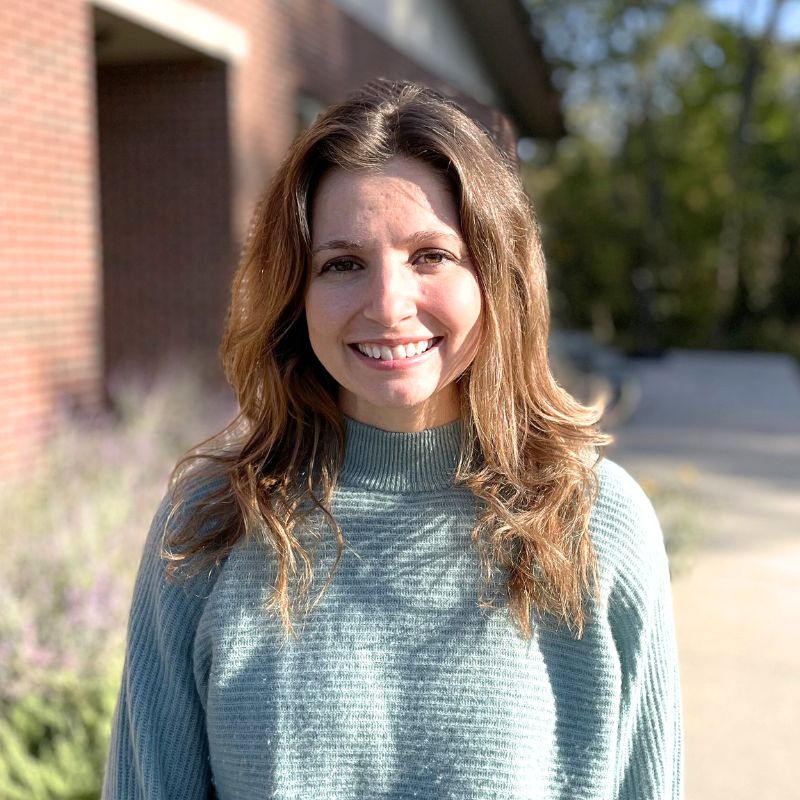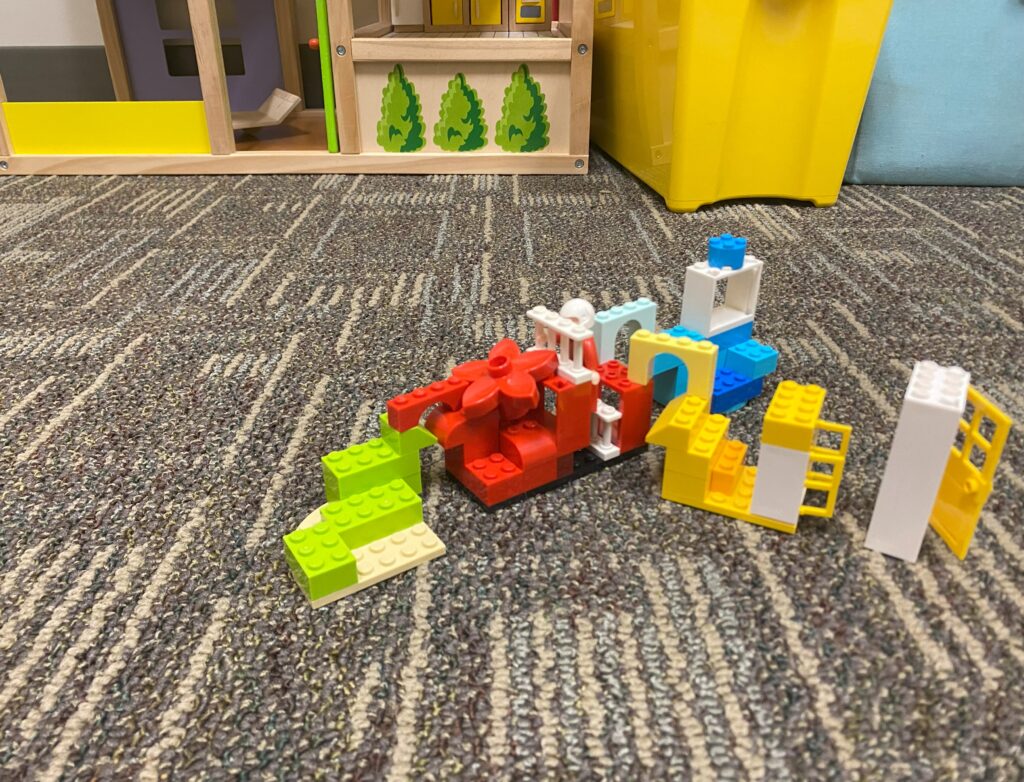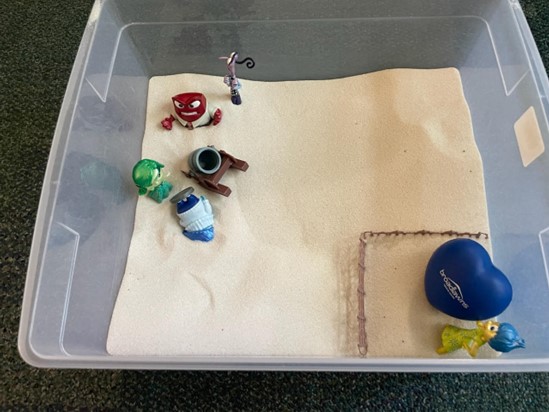
Trey Voeller
Meet Trey Voeller, a junior at PCM (Prairie City Monroe) High School! Trey organized a Mental Health Advocacy Day at his school that included multiple speakers, over a dozen mental health organizations throughout Iowa, and the entirety of the student body.

Trey standing in front of a few booths at the mental health fair

Staci sitting at the Center’s booth
Staci Fosenburg, a psychologist from the Center and a graduate of PCM, hosted a booth at the event. Staci said, “It was certainly a powerful experience to come back to PCM after all these years and to share what I’ve learned and value about mental health.”
Staci was so impressed by the event and Trey’s commitment to mental health advocacy that we decided to spotlight Trey’s hard work in a special blog post!
Shannon: Tell me about the event you organized at your high school.
Trey: The event was a mental health advocacy day for PCM High School students. It was an all-day event starting with a presentation, followed by a mental health fair, and ending with two more presentations. The first presentation was two adults from NAMI Central Iowa, Anglea Tharp, and McKenzie Lopez. Their presentation was about being a friend and identifying symptoms of different mental health issues. The mental health fair had 20 organizations from around central Iowa. These organizations were everything from therapy organizations to hospitals. Students came in eight different waves separated by grade and last name. These groups were small to keep personal conversations private. If there was still time, students could answer feedback posters. Finally, Eric Preuss spoke on behalf of Your Life Iowa. He talked about ways for students to reach out to get help, whether for themselves or a loved one struggling with mental health. Eric discussed where to go or who to go to with mental illness concerns and needs. The last speaker, a senior from Ottumwa, Iowa, was Lily Glenn. She spoke about her experience with mental health and anxiety and how she has found different activities and resources that help her.
Overall, the three speakers added personal stories that helped students learn that everyone has a different story, and they learned that people struggling with mental health issues are all around us. It was a very engaging day where students and the community came together to advocate for mental health.
After the event, I started to find student interest in a mental health club at our school. I am initiating a Stomp Out Stigma club which works through Please Pass the Love.

Shannon: What inspired you to host this event?
Trey: This past year I was accepted to serve on SIYAC (The State of Iowa Youth Advisory Council). This council works with the Iowa Department of Human Rights. On this council, I work on the health and service committees. On the health committee, I connected with many legislators from around the state during the 2022 Legislative Session. I learned that Iowa is 51st in the United States for mental health awareness and advocacy. When I took a step back, I was able to see how even in my community, mental health awareness is generally not discussed. We have a mental health day that allows us to play games, but students want resources when I asked them about the original mental health day. I decided to take a stand and get connections through the legislators I had met. One legislator that helped instrumentally is my Representative, Jon Dunwell.
Shannon: What were your goals for the event?
Trey: When I’ve been asked this question, there are two ways I would answer. The first is my personal story of fighting mental illnesses and being put in situations where I did not know what to do. I talked about how I was once in the position of holding the life of a friend. This situation helped me realize I never wanted to fear this situation because I did not know what to do, so I decided to inform those around me too! The other answer is, even if I impact one life or help someone save another life in the future, wouldn’t that be worth it? Isn’t one life worth all the effort?
Shannon: Tell me about how the event went and any feedback you heard from other students, teachers, or organizations who participated.
Trey: The Mental Health Advocacy Day went excellent. There were some bumps in the road with finding supplies and finalizing some of the information for the day. However, the day ran very smooth. The students received great resources with information. Students tried to get signatures from three tables, and they received them only if they had a meaningful conversation with the table presenter. Teachers were given snacks throughout the day with a sign that said, “Teacher Mental Health Matters Too!” Many teachers complimented the presenters because some of the past presenters at our school did not relate to students. Past presenters have often left students wondering, “How does mental health matter to us?” These presentations allowed them to be a friend, see the symptoms, how to reach out, and what to do to release the pressure from society. The organizations gave good feedback, and many said they hoped this event continued as they wished to attend again. I also had one organization say the communication I had with them made the entire day less nerve-wracking. Everyone, who attended and helped put this event together, created a network that benefitted everyone.

Shannon: What would you say to other students who care about mental health and want to make a difference?
Trey: If you want to make a difference, I would say you should advocate for it. Start by looking for a need/issue in your community. Then, bring awareness to that need/issue and inform others about what you want to change. We as youth have a voice, and some people are listening. Youth are the future, and when society invests in its future, it sets us up for success as leaders and future influencers. For students wanting to make a difference, you can find ways to get involved in your communities and around the state for these passions. For students who care about mental health specifically, look for what you are trying to get across. Mental Health is a broad subject with many smaller corresponding parts, and when you finalize the message you want to convey to others, a bigger impact can be made.
Shannon: Is there anything else you’d like our audience to know about you or the event?
Trey: I would like to thank Representative Jon Dunwell for financially supporting this event. Thanks to Mrs. Pohl for helping me plan this event and being my teacher advisor. Thank you to my mother and the Prairie City Police Department (Matt) for catering this event. Thank you to the organizations that came and gave resources to students, Newton HyVee for donating cookies, and the PCM School District for being accommodating. Lastly, I want to thank the Monroe Police Department, Monroe Presbyterian Church, and Monroe First Reformed Church for donating tables. This event was worth the effort, and I would recommend anyone to take the time to advocate for their passions and beliefs. Again, thank you to Representative Jon Dunwell and Ms. Samantha Pohl for supporting me with this entire process.

Staci sharing information with a student














